Ecg review acls program Study guides, Class notes & Summaries
Looking for the best study guides, study notes and summaries about Ecg review acls program? On this page you'll find 43 study documents about Ecg review acls program.
All 43 results
Sort by
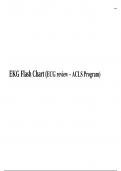
-
EKG Flash Chart (ECG review – ACLS Program) 2023/2024
- Exam (elaborations) • 10 pages • 2023
-
- $13.49
- + learn more
EKG Flash Chart (ECG review – ACLS Program) 2023/2024. Rhythm ECG Characteristics Example Normal Sinus Rhythm (NSR) Rate: 60-100 per minute Rhythm: R- R = P waves: Upright, similar P-R: 0.12 -0 .20 second & consistent qRs: 0.04 – 0.10 second P:qRs: 1P:1qRs Sinus Tachycardia Causes: Exercise Hypovolemia Medications Fever Hypoxia Substances Anxiety, Fear Acute MI Fight or Flight Congestive Heart Failure Rate: > 100 Rhythm: R- R = P waves: Upright, similar P-R: 0.12...
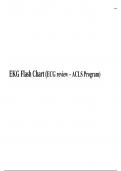
-
EKG Flash Chart (ECG review – ACLS Program)
- Exam (elaborations) • 10 pages • 2023
-
- $12.49
- + learn more
EKG Flash Chart (ECG review – ACLS Program). Rhythm ECG Characteristics Example Normal Sinus Rhythm (NSR) Rate: 60-100 per minute Rhythm: R- R = P waves: Upright, similar P-R: 0.12 -0 .20 second & consistent qRs: 0.04 – 0.10 second P:qRs: 1P:1qRs Sinus Tachycardia Causes: Exercise Hypovolemia Medications Fever Hypoxia Substances Anxiety, Fear Acute MI Fight or Flight Congestive Heart Failure Rate: > 100 Rhythm: R- R = P waves: Upright, similar P-R: 0.12 -0 .20 se...
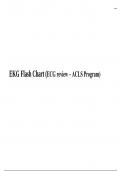
-
EKG Flash Chart (ECG review – ACLS Program) Updated
- Exam (elaborations) • 10 pages • 2023
-
- $10.49
- + learn more
EKG Flash Chart (ECG review – ACLS Program) Updated. Sinus Tachycardia Causes: Exercise Hypovolemia Medications Fever Hypoxia Substances Anxiety, Fear Acute MI Fight or Flight Congestive Heart Failure Rate: > 100 Rhythm: R- R = P waves: Upright, similar P-R: 0.12 -0 .20 second & consistent qRs: 0.04 – 0.10 second P:qRs: 1P:1qRs Sinus Bradycardia Causes: intrinsic sinus node disease increased parasympathetic tone drug effect. Rate: < 60 Rhythm: R- R = P wave...
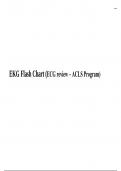
-
EKG Flash Chart (ECG review – ACLS Program) 2024
- Exam (elaborations) • 10 pages • 2024
-
- $12.49
- + learn more
EKG Flash Chart (ECG review – ACLS Program) 2024. Rhythm ECG Characteristics Example Normal Sinus Rhythm (NSR) Rate: 60-100 per minute Rhythm: R- R = P waves: Upright, similar P-R: 0.12 -0 .20 second & consistent qRs: 0.04 – 0.10 second P:qRs: 1P:1qRs Sinus Tachycardia Causes: Exercise Hypovolemia Medications Fever Hypoxia Substances Anxiety, Fear Acute MI Fight or Flight Congestive Heart Failure Rate: > 100 Rhythm: R- R = P waves: Upright, similar P-R: 0.12 -0 ....
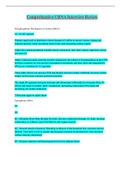
-
Comprehensive CRNA Interview Review Accurate responses are given.
- Presentation • 70 pages • 2023
-
- $14.49
- 2x sold
- + learn more
Comprehensive CRNA Interview Review Accurate responses are given. Comprehensive CRNA Interview Review Norepinephrine Mechanism of Action (MOA) A1, A2, B1 agonist. Primary agent used in distributive shock because it's ability to recruit venous volume and augment preload, while increasing arterial tone, and increasing cardiac output. Alpha one causing peripheral smooth muscle contraction. (low dose venous, high dose venous and arterial). Alpha 2 adrenoreceptor agonism actually ant...
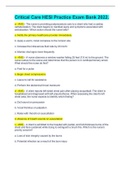
-
Critical Care HESI Practice Exam Bank 2022.
- Exam (elaborations) • 156 pages • 2022
-
- $14.69
- 1x sold
- + learn more
Critical Care HESI Practice Exam Bank 2022. - The nurse is providing postprocedure care to a client who had a cardiac catheterization. The client begins to manifest signs and symptoms associated with embolization. Which action should the nurse take? a. Notify the primary healthcare provider immediately b. Apply a warm, moist compress to the incision site c. Increase the intravenous fluid rate by 20 mL/hr d. Monitor vital signs more frequently - A nurse observes a window wa...
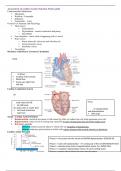
-
Assessment of cardiovascular function
- Exam (elaborations) • 23 pages • 2023
-
- $11.99
- + learn more
Cardiovascular Medication • Metoprolol • Warfarin - Coumudin • Diltiazem • Furosemide – Lasix Overview of Anatomy and Physiology • Three layers o Endocardium o Myocardium – muscle contraction and pump o Epicardium • Four chambers – know what is happening with s1 and s2 • Heart valves o Know where the valves are and what they do o Atrioventricular valves o Semilunar valves • Vasculature Structure of the Heart: Coronary Circulation Cardiac Conduction Syst...
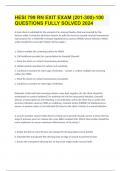
-
HESI 799 RN EXIT EXAM (709-810)-87 QUESTIONS WITH VERIFIED SOLUTIONS 2024
- Exam (elaborations) • 46 pages • 2023
- Available in package deal
-
- $14.49
- + learn more
A male client notifies the nurse that he feels short of breath and has chest pressure radiating down his left arm. A STAT 12-lead electrocardiogram (ECG) is obtained and shows ST segment elevation in leads II, II, aVF and V4R. The nurse collects blood samples and gives a normal saline bolus. What action is most important for the nurse to implement? a. Obtain the results for STAT serum cardiac biomarkers b. Asses for contraindications for thrombolytic therapy c. Measure ST-segment height...
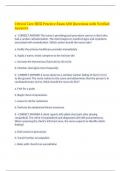
-
Critical Care HESI Practice Exam 600 Questions with Verified Answers,100% CORRECT
- Exam (elaborations) • 190 pages • 2023
-
- $13.99
- + learn more
Critical Care HESI Practice Exam 600 Questions with Verified Answers a - CORRECT ANSWER The nurse is providing post procedure care to a client who had a cardiac catheterization. The client begins to manifest signs and symptoms associated with embolization. Which action should the nurse take? a. Notify the primary healthcare provider immediately b. Apply a warm, moist compress to the incision site c. Increase the intravenous fluid rate by 20 mL/hr d. Monitor vital signs more fre...
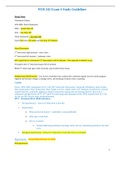
-
Nur 242 Exam 4 study guide.
- Other • 62 pages • 2022
-
- $10.99
- + learn more
Recap Notes Cholesterol Values LDL/HDL/Total Cholesterol HDL = greater than 40 LDL = less than 100 Total Cholesterol = less than 200 Lipids less than 150 males and less than 135 females Heart Placements 2nd intercostal right sternum = aorta valve 2nd intercostal left sternum = pulmonic valve Erb’s point best s1 s2nsound is 3rd intercostal to left of sternum – Not required to identify in cpe Tricuspid valve 4th intercostal space left of sternum Mitral 5th intercostal space mid clavicular, api...

How much did you already spend on Stuvia? Imagine there are plenty more of you out there paying for study notes, but this time YOU are the seller. Ka-ching! Discover all about earning on Stuvia


